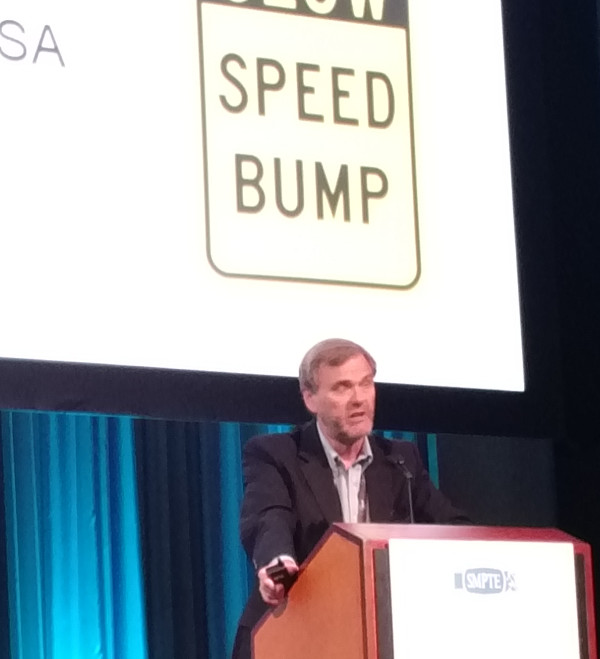Pete Putman started his presentation by noting that until 2012 or so, the existing connectivity standards like DVI and HDMI with pixel clocks up to 330MHz and data rates of 10.2 – 21.6 Gbps were quite adequate for display resolutions, bit depths and frame rates used in almost all applications. But with the arrival of UHD, pixel clock rates increased dramatically to 594 MHz for UHD/60 content. With the move to 10 bits per color and 4:4:4 color sampling, data rates of 21.4 Gbps were now needed for UHD/60.
For the first time, display signal requirements were starting to exceed the interfaces available to support them. HDMI reacted in September 2013 with the 2.0 spec increased data rates to 18 Gbps, but this was not sufficient to pass 2160/60p, 10 bit 4:4:4, which is required for many professional application and synthetic images. What does fit is 2160/60, 4:4:4 but at 8-bits per color. Many think this bit depth unacceptable as it will show banding on some scenes.

Things got worse as HDR and wide color gamut displays were introduced, further increasing bandwidth needs. HDMI 2.0 is inadequate and DisplayPort 1.2 at 21.6 Gbps is barely adequate, said Putman. As a result, DisplayPort 1.3 was announced in September 2014 to increase the data rate to 32.4 Gbps (including around a 20% overhead). That is sufficient for 2160/60, 4:4:4 with 16 bits per color. That’s great, but TV makers don’t use DisplayPort, said Putman. (although Panasonic, at least, had one in the early days of UHD – Man. Ed.)
Then the situation got worse still with the introduction of 5K and even 8K resolution 10-bit displays. What happens when content is distributed at 120 fps? The solution today is multiple connectors, but that is really not an acceptable solution so it is time for the display interface folks to “step on the accelerator. Should we shoot for 45 Gbps and use compression after that?” Putman asked.
On the IT side, DisplayPort 1.4 was announced at CES 2016 and has a physical layer of 4 lanes, each with 8.1 Gbps. But it also adds Display Stream Compression (DSC) for up to, perhaps, 3:1 compression. There is also support for USB Type-C and optical fiber.
HDMI Updated
HDMI 2.1 was announced at CES 2017 and changes the signal formatting to mimic that used in DisplayPort. It will support up to four lanes with each able to transmit at 12 Gbps. The forward error correction scheme also moved from the 10/8 bit configuration to 16/18 bit, thus reducing overhead from 20% to 11%. It is compatible with USB Type-C but there is no fiber option. HDMI 2.1 brings the maximum data rate to 48Gbps including overhead.
As an alternative, many are now considering using TCP/IP over standard networks to offer high bandwidth options with some light compression (such as JPEG2000). This will require a 10 GigE network, which are not as common as 1 GigE networks today.
Putman likes the DSC standard as it is a low latency entropy-based compression. Lossless compression up to 4:1 has now been demonstrated and it is compatible with DP 1.3/1.4 and HDMI 2.1, but not HDMI 2.0. That seems very strange, he noted. (In subsequent discussions, Putman told us that although he has heard ‘unofficially’ that HDMI 2.1 supports DSC, at the time of the discussion, he is not aware of any press or public communication that confirms this. CNET has also published that it has heard that it is supported).
Today, you still can’t get an HDMI 2.1 interface as the silicon is not yet available. DP 1.3 is available, but not DP 1.4. So the interface specifications are there, but the implementation is lacking as of today, he concluded.
Other papers at the conference described a new compression standard, JPEG-XS ( see our report IBC 2017 Roundup), that has been designed as a mezzanine (low compression, lossless) codec for video over IP and the Tico codec for 4K/8K production. – CC

